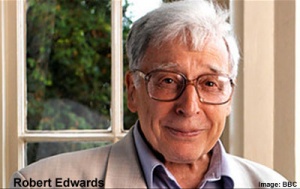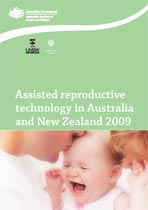Embryology History - Robert Edwards: Difference between revisions
No edit summary |
No edit summary |
||
| Line 3: | Line 3: | ||
[[File:Assisted_reproductive_technology_in_Australia_and_New_Zealand_2009.jpg|thumb|ART in Australia and New Zealand 2009]] | [[File:Assisted_reproductive_technology_in_Australia_and_New_Zealand_2009.jpg|thumb|ART in Australia and New Zealand 2009]] | ||
The first successful human IVF was carried out in the UK in 1978 by Robert G Edwards and Patrick Steptoe.<ref name="PMID6775685"><pubmed>6775685</pubmed></ref>Robert Edwards recently was awarded the 2010 Nobel Prize in Medicine. Patrick Steptoe died in 1988 and Nobel Prizes are generally not awarded posthumously. | The first successful human IVF was carried out in the UK in 1978 by Robert G Edwards and Patrick Steptoe.<ref name="PMID6775685"><pubmed>6775685</pubmed></ref> Robert Edwards recently was awarded the 2010 Nobel Prize in Medicine. Patrick Steptoe died in 1988 and Nobel Prizes are generally not awarded posthumously. | ||
| Line 23: | Line 23: | ||
==Key Papers== | ==Key Papers== | ||
'''Establishing full-term human pregnancies using cleaving embryos grown in vitro.'''<ref name="PMID6775685"><pubmed>6775685</pubmed></ref> "The establishment of human pregnancies by the use of fertilization in vitro and placing cleaving embryos into the uterus is described. Preovulatory oocytes were aspirated at laparoscopy from the ovaries of patients soon after the beginning of the mid-cycle surge of luteinizing hormone (LH) during the natural cycle. The LH surge was identified by assaying 3-hourly samples of urine, and measurements of oestrogens in 24-hour samples were used to assess follicular growth. The surge of LH was identified in 68 patients and it showed a diurnal rhythm. Preovulatory oocytes were aspirated from most of the patients. Fertilization and cleavage occurred in 34 instances, and 32 embryos were put into the mother via the cervical canal. Four patients became pregnant. There were indications that a diurnal rhythm played a role in establishing cleaving embryos, each of the four pregnancies occurring when the embryos were placed in late evening. Each of the pregnancies resulted from oocytes which were aspirated from their follicles 24 hours or longer after the LH surge began. Details are given of three abortive pregnancies in patients given gonadotrophins to stimulate the maturation of of oocytes used for fertilization in vitro." | |||
'''Test-tube babies, 1981'''<ref name=PMID7278985><pubmed>7278985</pubmed></ref> "Between fifteen and twenty babies will be born this year after the in vitro fertilization of human eggs. Many of the essential steps now have high rates of success, including the recovery of preovulatory oocytes, and fertilization and embryo cleavage in vitro. Implantation of the embryo following its replacement in the mother remains the major difficulty. Some implications of the work are discussed." | '''Test-tube babies, 1981'''<ref name=PMID7278985><pubmed>7278985</pubmed></ref> "Between fifteen and twenty babies will be born this year after the in vitro fertilization of human eggs. Many of the essential steps now have high rates of success, including the recovery of preovulatory oocytes, and fertilization and embryo cleavage in vitro. Implantation of the embryo following its replacement in the mother remains the major difficulty. Some implications of the work are discussed." | ||
==Historic Embryologists== | ==Historic Embryologists== | ||
Revision as of 15:10, 10 October 2012
Introduction
The first successful human IVF was carried out in the UK in 1978 by Robert G Edwards and Patrick Steptoe.[1] Robert Edwards recently was awarded the 2010 Nobel Prize in Medicine. Patrick Steptoe died in 1988 and Nobel Prizes are generally not awarded posthumously.
The Latin, In vitro = "in glass" meaning in essence a test tube as apposed to in vivo (in life or a living body). Note that even in vivo fertilization can also now be assisted through some fertility drug treatments. Both processes have the same biological outcome, fusion of male and female gametes to form a diploid zygote.
The now many different reproductive options are know as Assisted Reproductive Technologies (ART) and this technique continues to grow worldwide with development of new medical technologies. In vitro fertilization covers the aided fertilization process, in contrast with in vivo fertilization which is the normal uterine occuring fertilization process.
In Australia, the first successful IVF occurred in 1980.[2]. by 2005 1,596 babies and in 2009 13,114 liveborn babies in Australian and New Zealand. (ART report 2011)
The Nobel Prize in Physiology or Medicine 2010
Awarded to Robert G. Edwards "for the development of in vitro fertilization" who battled societal and establishment resistance to his development of the in vitro fertilization procedure, which has so far led to the birth of around 4 million people.
- Links: 2010 Nobel Prize
Key Papers
Establishing full-term human pregnancies using cleaving embryos grown in vitro.[1] "The establishment of human pregnancies by the use of fertilization in vitro and placing cleaving embryos into the uterus is described. Preovulatory oocytes were aspirated at laparoscopy from the ovaries of patients soon after the beginning of the mid-cycle surge of luteinizing hormone (LH) during the natural cycle. The LH surge was identified by assaying 3-hourly samples of urine, and measurements of oestrogens in 24-hour samples were used to assess follicular growth. The surge of LH was identified in 68 patients and it showed a diurnal rhythm. Preovulatory oocytes were aspirated from most of the patients. Fertilization and cleavage occurred in 34 instances, and 32 embryos were put into the mother via the cervical canal. Four patients became pregnant. There were indications that a diurnal rhythm played a role in establishing cleaving embryos, each of the four pregnancies occurring when the embryos were placed in late evening. Each of the pregnancies resulted from oocytes which were aspirated from their follicles 24 hours or longer after the LH surge began. Details are given of three abortive pregnancies in patients given gonadotrophins to stimulate the maturation of of oocytes used for fertilization in vitro."
Test-tube babies, 1981[3] "Between fifteen and twenty babies will be born this year after the in vitro fertilization of human eggs. Many of the essential steps now have high rates of success, including the recovery of preovulatory oocytes, and fertilization and embryo cleavage in vitro. Implantation of the embryo following its replacement in the mother remains the major difficulty. Some implications of the work are discussed."
Historic Embryologists
| Embryologists: William Hunter | Wilhelm Roux | Caspar Wolff | Wilhelm His | Oscar Hertwig | Julius Kollmann | Hans Spemann | Francis Balfour | Charles Minot | Ambrosius Hubrecht | Charles Bardeen | Franz Keibel | Franklin Mall | Florence Sabin | George Streeter | George Corner | James Hill | Jan Florian | Thomas Bryce | Thomas Morgan | Ernest Frazer | Francisco Orts-Llorca | José Doménech Mateu | Frederic Lewis | Arthur Meyer | Robert Meyer | Erich Blechschmidt | Klaus Hinrichsen | Hideo Nishimura | Arthur Hertig | John Rock | Viktor Hamburger | Mary Lyon | Nicole Le Douarin | Robert Winston | Fabiola Müller | Ronan O'Rahilly | Robert Edwards | John Gurdon | Shinya Yamanaka | Embryology History | Category:People | ||
|
Bourn Hall Clinic
- "Two years after achieving the first birth through IVF in 1978, with the longed for arrival of Louise Brown, Mr Patrick Steptoe and Professor Robert Edwards achieved another first – a new clinic that made IVF treatment available to couples with difficulties conceiving. The result has been many children who otherwise would never have been born - and the birth of a whole new area of medicine undertaken here at Bourn Hall Clinic over the last three decades."
(text Bourn Hall history)
References
See also - References
Reviews
<pubmed>18339268</pubmed> <pubmed></pubmed> <pubmed>10098471</pubmed> <pubmed>9395264</pubmed> <pubmed>9184332</pubmed> <pubmed>2207610</pubmed> <pubmed>3310753</pubmed> <pubmed>2858857</pubmed> <pubmed>4598817</pubmed> <pubmed>4274030</pubmed>
Articles
<pubmed></pubmed> <pubmed></pubmed> <pubmed></pubmed> <pubmed></pubmed> <pubmed>4178888</pubmed>| PMC2279076 <pubmed>4165802</pubmed> <pubmed>4957259</pubmed>| PDF <pubmed>13475597</pubmed> <pubmed>13235857</pubmed>
Search PubMed
Search PubMed Now: Author - Edwards+RG
External Links
External Links Notice - The dynamic nature of the internet may mean that some of these listed links may no longer function. If the link no longer works search the web with the link text or name. Links to any external commercial sites are provided for information purposes only and should never be considered an endorsement. UNSW Embryology is provided as an educational resource with no clinical information or commercial affiliation.
- 2010 Nobel Prize
- Controversies in Obstetrics, Gynecology and Infertility Nobel Prize Laureate – Robert G. Edwards: First annual lecture
- BBC - The New Elizabethans James Naughtie considers Nobel Prize-winning scientist Robert Edwards who, with colleague Dr Patrick Steptoe, was the pioneer of in vitro fertilisation.
- Bourn Hall Clinic
- European Society for Human Reproduction and Embryology
Glossary Links
- Glossary: A | B | C | D | E | F | G | H | I | J | K | L | M | N | O | P | Q | R | S | T | U | V | W | X | Y | Z | Numbers | Symbols | Term Link
Cite this page: Hill, M.A. (2024, April 18) Embryology Embryology History - Robert Edwards. Retrieved from https://embryology.med.unsw.edu.au/embryology/index.php/Embryology_History_-_Robert_Edwards
- © Dr Mark Hill 2024, UNSW Embryology ISBN: 978 0 7334 2609 4 - UNSW CRICOS Provider Code No. 00098G


